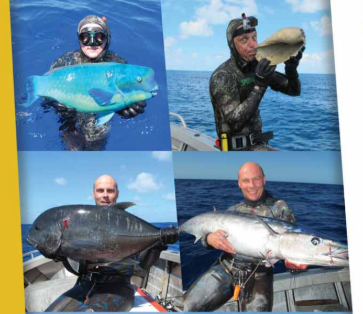
November 2013 saw me jetting off to Australia, heading off the Cairns coastline into the Coral Sea with Frog Dive on the Eastern Voyager. My primary goal for the trip was to land a Coral Trout of under 30cm – one of the most prized fish to spear in Australia. This, along with the ability to shoot crayfish with a 1.5m double rubber wooden drop head gun, proved to be technically challenging for a South African used to shooting gamefish with a 1.2m reel gun.
Conditions aboard the Eastern Voyager were fairly cramped but the slick crew managed to get the tenders into the water with relative ease. With 21 divers on board and only 4 crew, it did make things rather cramped… but despite this, cameraderie on the boat was excellent. The food and beer was plentiful and the boat was comfortable.
We had 5 of us on our tender: Jono Stevens, Two Dogs, John Howlett, Sharky and myself. Five up on a tinny with a 30hp on the back, along with 10 Riffe floats, 10 guns (the smallest being a 1.4 double wrap) and about 700m of bungi did prove problematic at times. At any one time when you were top man, there were at least four ‘puzzles’ to solve in the form of tangled buoy lines.
Our first stop was the Swains Reef System, which saw us diving between 14 and 22 metres. We’d already been in Gladstone for a full day and a night (and had been introduced to some of the ‘night life’) and were all eager to get into the water. It turned out to be an excellent spot to warm up on after a day and a half of getting ready.
Swains Reef System delivered some stunning new species for me, including Parrot Fish, Coral Trout and Large Eye Sea Bream. This is also the furthest East that Couta (Spanish Mackerel) are found, though only one was landed on the trip.
Another half a day and night steaming across the water took us to the Frederick Reef System, and it was here that we encountered our first Dog Tooth Tuna. Fredericks delivered some of the best Doggie sightings that we had on the trip. Many other incredible fish were sighted, including a Marlin of over 200kg, several Wahoo, some big Kakaap… as well as some fairly intense shark action.
A note on equipment: go BIG! Use lots of floats, with plenty bungis. I was a bit under-gunned. Some of the guns the guys had could have been used as boats – 8 rubbers with 12m long spears! (The super long guns combined with multiple floats made the turnaround time getting on and off the tinnies time consuming.) The Aussies also prefer a drop head set up, and this did help them land fish, even when the shot placement was not perfect.
When diving so far away from civilisation, safety is paramount. Attached to our weight belts were whistles and a 3m inflatable orange marker buoy. Strict times had to be adhered to, with a return to the Eastern Voyager at lunch for an hour and a half and back at the boat by no later than 4.30pm. We were lucky enough to keep the same crew on our tinny throughout the trip, which I think had a big effect on the ability for us to work as a team during the course of the trip.
During a day of particularly calm weather, we steamed out to a system of undersea atolls called the Calder Banks and it was here that the biggest Doggies were not only seen, but also landed. The shark population here was exceptionally healthy and being a complete wilderness, the sharks were more friendly than the nightlife of Gladstone! This was where John Howlett speared one of the nicest Doggies of the trip. I must say, that diving a system – one up, one down and two fending off sharks – was the only way any fish were landed and we managed to get more fish out towards the end of the day’s diving.
Over the 10 day trip we spent 8 days in the water which is pretty good considering how far out we were. From Cairns we travelled over 120 nautical miles out to sea. Despite the distance, the Australian authorities were patrolling aggressively, both by plane and boat. It is good to see such a focus on preservation and the management of fish stocks. One of their big risks in this area is ciguatera and high metal levels in some of the gamefish. Ignobilis can’t be taken because of both ciguatera and heavy metals, and any bottom fish over 40cm is considered exceptionally dangerous.
Surprisingly, the biggest fish of the trip was a bottom fish: a 53kg monster of a Parrot! AJ lucked this trophy and has prevented massive further reef damage. It was the fish of a lifetime – well done mate! The most prolific bottom fish was the Blue Parrot, and the most prolific game fish was by far the Kakaap (Job Fish).
For me, highlights of the trip were watching Jon get his first Doggie and seeing the guys on our tender all getting PB’s on a number of different species… and of course being privileged to dive in an ocean wilderness. Visibility of over 50m at times was also super!
In all, it was a fantastic trip – although more time on the outlying reefs would have been fun. Diving in the Coral Sea is an absolute must for any spearo and should be on everyone’s bucket list.
Many thanks to Luke of Frog Dive, and the 4 crew of our tinny!
